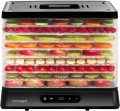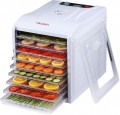Type
–
Vertical fruit dryer. Vertical models of dryers involve loading vegetables and fruits on perforated trays, which are placed one above the other in several tiers. The heating element and the fan in their design are at the bottom, and hot air is blown from the bottom up. As a result, products on the lower shelves dry much faster than those on the upper levels. During the drying process, it is often necessary to swap the upper and lower trays. In many instances of vertical dryers, this disadvantage is eliminated due to the successful shape of the pallets.
—
Dehydrator (horizontal dryer). Horizontal dehydrators are better than vertical ones. Often they are made in the image and likeness of small ovens with pull-out trays to place products. Hot air in the oven of the horizontal type dryers is blown by a fan, which is installed on the rear wall perpendicular to the trays with vegetables and fruits. Horizontal airflow ensures uniform drying of products at all levels. However, the pricing policy for devices of this order is more “biting”.
Tray size
Horizontal dimensions of one dryer tray.
For round models, this paragraph usually indicates the diameter (for example, “Ø250”), for other cases — the length and width. Anyway, the information about the size allows you to estimate the total area and, accordingly, the capacity of the device. At the same time, note that a larger size affects the dimensions and weight of the structure, and also requires more heating power (ceteris paribus).
Total capacity
The total volume of all dryer trays. The larger the volume, the more products can be loaded into the device at a time. For modern dryers, a capacity of
up to 10 L is considered relatively small,
from 11 to 15 L — medium,
from 16 to 20 L — high, and the largest models can hold
more than 20 L.
Note that if you plan to dry several different types of fruits or vegetables at the same time, it is worth considering not only the total volume of the dryer, but also the number of trays (see above).
Power consumption
Rated power consumed by the dryer during operation.
This parameter is usually selected by manufacturers depending on the volume of the dryer: the larger the device, the more power is needed to effectively heat the working chamber. At the same time, models with the same volume may differ in power consumption. In such cases, it is worth considering that a higher power reduces the heating time, but affects the price of the device.
Tray for marshmallow
Availability
of a tray for a marshmallow in a set of delivery of the dryer.
Such a device differs from ordinary trays in the design of the bottom — it is solid, without openings. This is due to the fact that the raw material for the preparation of marshmallows is fruit puree, which simply would not have stayed on the classic grating bottom. Most often, there is only one tray for marshmallows, however, in some models it may be possible to purchase additional trays of this type.
We emphasize that it is undesirable to use such accessories for more traditional ingredients (pieces of vegetables, fruits, etc.): in some cases this reduces the drying efficiency, in others it can lead to damage to the contents.
Location of the fan (heater)
The location of the heating element (fan with heater) installed in the food dehydrator. This element can be installed at the
bottom,
top or
behind, here are the features of each of the options:
— Bottom. The classic and most common arrangement for heaters in food dehydrators is located at the bottom. This design choice offers two main advantages. Firstly, warm air is evenly distributed throughout the dryer's volume as it rises from the bottom. Secondly, these devices have compact dimensions in terms of width and depth, which are mainly determined by the size of the trays. This allows for more flexibility in terms of placement options. However, a potential drawback of the lower heater placement is the possibility of contamination, which can result in unpleasant odors. In such cases, disassembling and thoroughly cleaning the dryer may be required. Nonetheless, most manufacturers take steps to address this issue, making it less of a critical concern.
— Top. The safest location for the heater in a food dehydrator is considered to be at the top, as it minimizes the risk of moisture from the dried products coming into contact with the heater. Similar to the previously mentioned design, the width and depth of the food dehydrator do not exceed the size of the trays. However, dehydrators with a top-mounted heater may not provide uniform heating. Warm air tends t
...o accumulate in the upper part of the device, resulting in the upper trays being heated more than the lower ones. In theory, this can be advantageous for drying products that require different temperature conditions, as higher-temperature items can be placed higher in the dehydrator. However, in practice, it is challenging to account for the actual temperature difference accurately. This aspect becomes a clear disadvantage when drying uniform ingredients, as it requires periodic rearrangement of the trays to achieve even processing. As a result, there are fewer models with a top-mounted heater available nowadays.
— Behind. Food dehydrators in this category have a layout that differs from the previously described options. They resemble ovens with baking sheets, where a common working chamber is used instead of separate trays stacked on top of each other. Inside the chamber, lattice shelves are fixed with special slots or protrusions on the walls. The heater is located at the back of the "oven". This design is considered highly advanced, as it allows for easy removal and placement of individual trays without disturbing the others. It also provides very uniform heating and minimizes the mixing of odors between different levels. Moreover, the lattice shelves can be rearranged to increase the height of specific "trays". However, the drawbacks of models with a rear heater include their bulkiness and higher cost. As a result, this layout option is primarily used in semi-professional and higher-level food dehydrators.Control
The control panel of a fruit dehydrators.
— Control knob.
Mechanical control is carried out using rotary knobs and switches. Most parameters in such devices are set and controlled manually. In this case, the control elements are connected to the working parts of the dryer directly, without additional electronic circuits. This option is simple, reliable and low cost; however, it is only suitable for the most basic functions, but dehydrators for fruits, vegetables and mushrooms usually do not require more. But the obvious disadvantage of mechanical control is low accuracy: for example, a mechanical timer most often gives an error of a couple of minutes, which in some cases can be critical.
–
Push-button. Push-button control is based on electronic circuits. Such systems are more accurate than mechanical ones (for example, the timer in such dryers can usually be set with an accuracy of several seconds), and more options and modes are provided. On the other hand, such control is more complex and more expensive than mechanical control.
–
Touch. A type of
electronic control with touch switches. Compared to push-button models, it provides a high level of comfort in operation, and looks more modern and aesthetically pleasing. Touch control is found mainly in top models of dehydrators.
Shutdown timer
A special device that turns off the heating after a predetermined time.
The presence of a
timer greatly simplifies the use of the device: instead of monitoring the duration of the process and manually turning off the heater, it is enough to set the desired turn-off time in the settings. In addition, this function reduces the risk of forgetting about drying products and “overexposing” them in the dryer: this can only happen if the timer was initially set for too long.
Note that the type of timer directly depends on the type of control (see above); at the same time, mechanical timers are simple and inexpensive, but they have a rather noticeable error, and electronic ones are very accurate, but they cost accordingly more.

